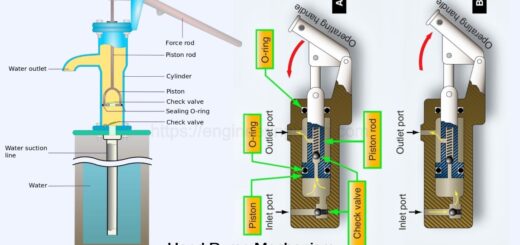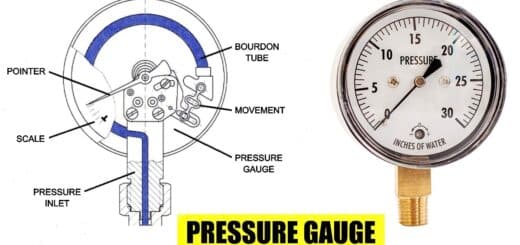Types of Shaft Keys: Definition, Use, Function, Advantages & Disadvantages

What is Shaft Key?
Types of Shaft Keys: Definition, Use, Function, Advantages & Disadvantages :- Shaft key can be defined as the piece of metal which is used for connecting the rotating machine element with shaft. It is generally used for the prevention of relative rotation between two parts and they are able in transmission of torque to take place. The rotating element (such as pulley, gear) and the shaft should have a key seat and a keyway for the proper functioning of a shaft key. A pre-cut slot is present in shaft in which one part of shaft key can fit and the other part of shaft key fit into a keyway which is a slot provided in the hub. The overall system is known as keyed joint and is able to provide relative axial movement between two parts.
Shaft key can be made up of a number of materials, most commonly from steel. These keys are also available in various shapes and sizes. Tapered or rectangular are the most common shape of shaft key.
They keyway which is a slot provided in hub of a gear, sprocket, pulley and various rotating power devices which can receive key. The slot in hub is cut on key seating machines by milling, shaping, broaching, slotting and planning.
The overall system which is called as keyed joint is a essential part of elements which can transmit mechanical power where they ensure connection is transmitting the power, load and rotation in accuracy without slipping according to the design requirement.
Types of Shaft Keys
Following are the types of shaft key:
1. Parallel Keys: ( Types of Shaft Keys )
These keys can be square or rectangular with regular in thickness and width all over. They are taper less and can be used at the place where gear, pulley and other mating part are needed to slide beside shaft. They are commonly used in automotive engineering and mechanical engineering due to their ease of installation and availability.
Parallel keys are generally used for transmitting the unidirectional torques which have light initial loads and at the place which need sliding of hub or periodic clearance.
2. Sunk Keys: ( Types of Shaft Keys )
Sunk key is a type of key which can fit into the keyways in both the member in machinery as well as in the shaft. To the half of the thickness of the shaft sunk keys are sunk and from the side of the key measurement are taken. Sunk keys are of several of types such as Woodruff key, Gib head key, Feather key, Parallel sunk key, Square sunk key, Rectangular sunk key.
3. Rectangular and Square Sunk Keys: ( Types of Shaft Keys )
These keys are usual proportion of width and thickness of key and diameter of hole in hub or the diameter of the shaft. They are installed in shaft for transmitting gear from shaft to shaft and other element. Machine keys are made up of same material but are generally tougher and harder than other components as well as shafts with which they are to be used but sometimes soft keys are chosen so that it will turn off at the time of excessive force therefore prevent the damage of expensive equipment.
One of the major difference between square sunk key and the rectangular sunk key is that in case of a square sunk key the width and the thickness are equal. Square sunk keys are generally used for shafts with their diameter between 0.635 cm to 2.54 cm but there are some larger keys of diameter about 6.5 inch are available for the shafts.
4. Feather Keys: ( Types of Shaft Keys )
These are rectangular keys which is used for connecting the shaft’s keyway and hub of pulley or gear and can be fastened by one keyway and are free for sliding from other therefore the hub are driven by shaft at different positions with it.
Feather keys are drive key which can used for transmitting the torque from shaft to the driven component. Shaft’s mating slot is machined with end mill which matches with the design of shaft key radius. When the key is installed they are contained in machined pocket and are not able to move axially.
These keys are parallel key and can be rectangular and square. The shaft’s mating key slot are mechanized with the end mill cutting tool with same length of wing key and the oval shape restrict the axial motion and hold the key in shaft.
Feather keys have various benefits over the tradition keys:
- The assembly is simplified and the keys are inserted easily in the shaft. Radius helps in aligning the key in the slot of the shaft.
- The keys are completely contained and the keys cannot come out of assembly.
- Reforms and disassembly of the feather key is trouble free.
- Feather key cannot come out of the shaft and results in damaging the nearby machines, generally in case of loose key damage and injury take place.
- Feather key do not require any cutting, measuring, fitting or filling because they can be undone to same length.
- Feather key after installing cannot run axially which results in adjusting the position of component which is mounted along the shaft.
5. Splines Keys: ( Types of Shaft Keys )
Splines keys are generally formed with shaft inseparably and they can fit with keyway which is fitted to hub and these shafts are also called splendid shafts. Splines keys have generally sixteen, ten, six or four partitions. In comparison with single keyway shafts, peeled shafts are stronger.
For force transmission in sliding gear transmission and automobile transmission spoiled shafts are used. With the use of split shafts, we can have a positive drive as well as axial movement.
6. Gib Head Keys: ( Types of Shaft Keys )
These keys are notched machine keys which are tapered and are used for power transmission in keyed shaft for holding the gears and pulleys tightly on the shaft. The head of the key reduce the effect of hammering and prevent the damage to the shaft. The axial position is controlled by the depth in slot in shaft as well as the component.
More keyway depth or key slot enable to slide the key into the slot and therefore came in contact with component face. Therefore we cannot rely on the gib head key and can expect it to be failed.
7. Woodruff Key: ( Types of Shaft Keys )
These keys are shaft key which are made in segment form of disk and can be used with the shaft of less than 6.35 cm diameter. These keys left a flat end protruding after being placed. The keyway have semi circular pocket which set in the shaft, and the pockets are set by the help of a cutter for setting the dimensions. These keys are used for the improvement of concentricity of shaft for the operations of high speed. The major advantages of using these keys are to eliminating making of keyway around the place which has stress. Material used for woodruff keys are generally stainless steel.
8. Tangent Keys: ( Types of Shaft Keys )
These keys are generally used for heavy duty equipment. Tangent key are a pair, and the pair of keys are kept at a right angles with each other and are tangent with the shaft’s surface. Each of the pair key can resist torsion in only one direction. Keyway is almost same to parallel key but the only difference is that it can exits tangent to inner shaft from the outer shaft. For shaft’s reversible motion one more key is required with the tangent to opposite direction. The tangent keys can be of any shape such as rectangular, square or wedge. However the most commonly used tangent keys are rectangular double taper keys.
9. Circular or Round Keys: ( Types of Shaft Keys )
These keys have circular section and are partially drilled in the holes of hub and partially in shaft. The major advantage using round key is that their key drills are performed again after assembling the mating part. They are best suited for generally low power drives.
10. Saddle Keys: ( Types of Shaft Keys )
These keys are used to secure a member with the machine shaft which can fits with the machine shaft which can fits with the keyway in member and they are concave so that they can grip the shaft with friction. As compared with sunk keys, these keys cannot sunk in shaft and hub, they can sunk in the hub only.
Saddle key generally sit on circumference or a flat of shaft. Transmission of power is done by the friction in between the key and the shaft.
Generally Saddle Keys are of Two Types:
A) Flat Saddle Key
These are taper key which is fit in the keyway provided in hub and they lie flat on shaft. They are usually used for light loads.
B) Hollow Saddle Key
These are taper keys which can fit in the keyway provided in hub. These key are gripped with friction and they are usually used for light loads and are used for temporary fastening in case of fixing and installation of cams, eccentrics etc.
Advantages of Shaft Keys
- Their construction cost is less.
- Used for high to medium transmission.
- They are easily dismantled as well as reusable.
Disadvantages of Shaft Keys
- They need stop lock for transmitting axial force.
- They can result in imbalance in shaft.
- For shaking and alternating directional loads they are not suitable.
- After long time, it is difficult to eliminate the joint.













